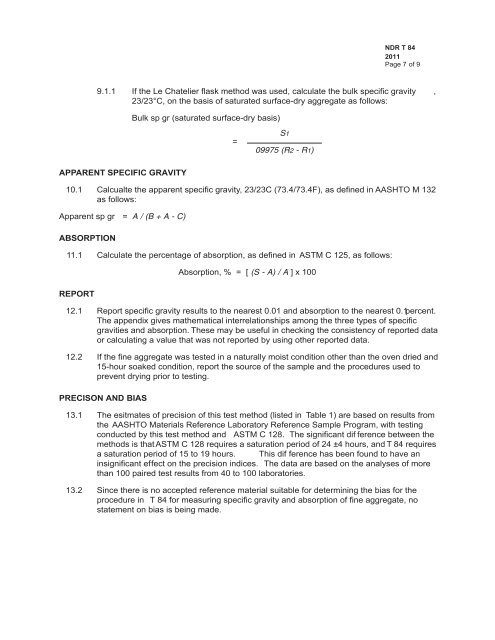specific gravity and absorption of fine aggregate - Nebraska ...
specific gravity and absorption of fine aggregate - Nebraska ...
specific gravity and absorption of fine aggregate - Nebraska ...
You also want an ePaper? Increase the reach of your titles
YUMPU automatically turns print PDFs into web optimized ePapers that Google loves.
NDR T 842011Page 7 <strong>of</strong> 99.1.1 If the Le Chatelier flask method was used, calculate the bulk <strong>specific</strong> <strong>gravity</strong> ,23/23°C, on the basis <strong>of</strong> saturated surface-dry <strong>aggregate</strong> as follows:Bulk sp gr (saturated surface-dry basis)=S109975 (R2 - R1)APPARENT SPECIFIC GRAVITY10.1 Calcualte the apparent <strong>specific</strong> <strong>gravity</strong>, 23/23C (73.4/73.4F), as de<strong>fine</strong>d in AASHTO M 132as follows:Apparent sp gr = A / (B + A - C)ABSORPTION11.1 Calculate the percentage <strong>of</strong> <strong>absorption</strong>, as de<strong>fine</strong>d in ASTM C 125, as follows:REPORTAbsorption, % = [ (S - A) / A ] x 10012.1 Report <strong>specific</strong> <strong>gravity</strong> results to the nearest 0.01 <strong>and</strong> <strong>absorption</strong> to the nearest 0.1percent.The appendix gives mathematical interrelationships among the three types <strong>of</strong> <strong>specific</strong>gravities <strong>and</strong> <strong>absorption</strong>. These may be useful in checking the consistency <strong>of</strong> reported dataor calculating a value that was not reported by using other reported data.12.2 If the <strong>fine</strong> <strong>aggregate</strong> was tested in a naturally moist condition other than the oven dried <strong>and</strong>15-hour soaked condition, report the source <strong>of</strong> the sample <strong>and</strong> the procedures used toprevent drying prior to testing.PRECISON AND BIAS13.1 The esitmates <strong>of</strong> precision <strong>of</strong> this test method (listed in Table 1) are based on results fromthe AASHTO Materials Reference Laboratory Reference Sample Program, with testingconducted by this test method <strong>and</strong> ASTM C 128. The significant dif ference between themethods is that ASTM C 128 requires a saturation period <strong>of</strong> 24 ±4 hours, <strong>and</strong> T 84 requiresa saturation period <strong>of</strong> 15 to 19 hours. This dif ference has been found to have aninsignificant effect on the precision indices. The data are based on the analyses <strong>of</strong> morethan 100 paired test results from 40 to 100 laboratories.13.2 Since there is no accepted reference material suitable for determining the bias for theprocedure in T 84 for measuring <strong>specific</strong> <strong>gravity</strong> <strong>and</strong> <strong>absorption</strong> <strong>of</strong> <strong>fine</strong> <strong>aggregate</strong>, nostatement on bias is being made.
















